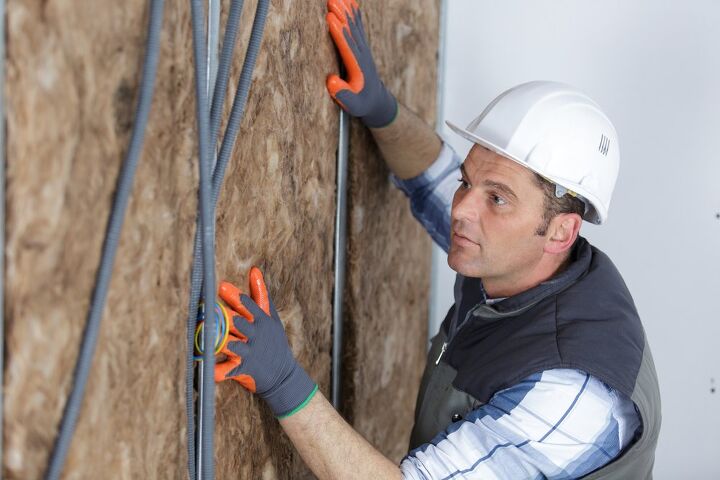R13 Vs. R15: Which Insulation Is Better?

Installing insulation isn’t the most exciting home improvement project, but it is a necessary one. As you probably already know, using insulation in your home is essential for improving efficiency and comfort. But how do you decide what kind of insulation is the best choice for your home? One of the most common questions homeowners ask is: what is the difference between R13 and R15 insulation?
R13 and R15 offer the same thermal performance, but R15 is more efficient due to the higher R-value. The heat resistance is slightly more impressive with R15 insulation, which makes a slight difference in temperature regulation. Both R13 and R15 insulation are great for pest control and noise reduction.
Recommended R-values for insulation go as high as R-60. Typically, the farther north you go, the higher the suggested R-value. In areas of the country where R15 is recommended for floor or wall insulation, R13 is also a valid option. In this article, we will discuss the aspects of insulation, as well as what precisely the R-value means, and how you can apply that to your decision making process.
Insulation R-Value
R-value is the measure of a product’s efficiency for resisting heat flow. The higher the r-value, the more effective it is. It’s essential to recognize that not all insulation is created equal. There are numerous types of insulation, from spray foam to fiberglass batting and rolls to blown-in, rock wool, and cellulose. Each of these varieties feature unique R-values, with spray foam usually having the highest thermal performance.
However, spray foam is also the most expensive option, and it should be installed by a professional, adding labor costs to your project. The most often used form of insulation is fiberglass rolls and batting, as it is easier to install and more economical.
Depending on what it is you are insulating, you might need a higher or lower R-value. Attic spaces and high ceilings require the highest r-value insulation followed by the floors and finally the walls. Remember, it’s all about keeping the heat both out and in to maximize comfort. That way, your home stays cool in the summer and warm in the winter.
When choosing between R15 or R13 insulation, it will most likely be for wall or floor insulation.
If you live in a cold region, insulation keeps heat inside where you need it the most. If you live in a hot climate, the insulation helps keep the heat outside where it belongs. The R-value is your quick guide to determine how effective insulation is at controlling this balance of heat.
Understanding Insulation And R-Value
Choosing Insulation
It can be intimidating to choose one insulation over another due to all of the options out there. Choosing the right insulation is a matter of energy savings, comfort, and even safety. Though you may be tempted to always go for the highest rated R-value for any project, but this isn’t ideal. Too much insulation can have negative financial and environmental effects on your home.
That said, there are several factors to consider when deciding on the ideal R-value for you, such as:
- What are you insulating?
- Where do you live?
- What is your budget?
What Are You Insulating?
As mentioned previously, if you insulate your floors, you will need a lower R-value than what you would use for your attic. The R-value for walls usually falls somewhere in between the R-value for the floor and the attic. (Easy to remember since your walls are literally in between these two spaces!)
Depending on your home’s structure and the heating and cooling system you have, you may or may not insulate every part of your house. You can insulate your roof, floors, windows, doors, and walls.
It’s also important to consider the orientation of individual rooms in your home. For example, if a particular place gets a lot more direct sunlight than others, this room might require extra insulation. Always consider your desired comfort level when installing insulation.
Where Do You Live?
Where you live will impact what kind of insulation you need. For example, if you insulate your floors and live in Florida, R13 would be sufficient. However, if you live in New York, you will need R25 to R30 insulation for the same project.
Temperature affects R-value, and insulation performs better in cooler temperatures than in hot settings. Higher R-values indicate that insulation is more heat resistant, and it is ideal if you live in a hot climate. Choose insulation that is rated for a higher or lower R-value based on your climate.
The Department of Energy divided the country into seven different zones as a method to recommend appropriate R-values for insulation. Based on where you live, you can use this chart to determine the proper R-value for your project.
Using the below charts, you can determine your zone and recommended R-value for your particular project.
What Is Your Budget?
In most instances where you would use R15 insulation, R13 is also a viable alternative, and the difference in price between the two is relatively low. The exception in the above chart is if you are insulating a cathedral ceiling in Zone 1 of the country. For this project, the R-value goes as low as R15, but it does not go any lower.
The overall price to install both types of insulation will depend on how much you need, where you live, what type of insulation you have, and where you are insulating.
R13 Vs. R15
As the names suggest, R13 and R15 differ in terms of their R-value. That means that their noise reduction, fire resistance, heat resistance, and performance are slightly different. Here are the main differences between the two:
- R15 insulation has better thermal resistance.
- R13 insulation is more affordable.
- R15 insulation can in installed in exterior walls, floors, and some attic spaces, whereas R13 insulation is only used in floors and walls.
- R13 insulation fits in narrow spaces while R15 insulation is too bulky.
However, R13 and R15 insulation are alike in many ways, too:
- Both provide adequate thermal protection when used correctly. In other words, if you follow the recommendations in the insulation charts, both R13 and R15 deliver good results.
- Both come faced or unfaced. If insulation is faced, it includes a kraft paper vapor barrier to help protect against moisture. Unfaced insulation doesn’t include a barrier and is a good choice if you will be adding the insulation on top of existing insulation (more on this below).
- Both are usable in 2 x 4 walls. Most homes use 2 x 4 studs in the walls. Since a 2 x 4 is not actually 4 inches deep, your wall cavity is about 3.5 inches, making both R13 and R15 a good fit. If you have 2 x 6 walls, you will need R19 or higher.
When it comes to insulation, there is more to consider than simple heat control. Insulation can also help reduce noise, control pests and moisture, and of course, increase your home’s energy efficiency. Let’s take a look at the several categories where R13 and R15 either differ or are similar.
Noise Reduction
Insulation can help reduce noises from both outside of the home and from inside the house. If you want significant noise reduction, you will want to consider specific sound barrier insulation designed for soundproofing.
However, standard insulation can cut down on the noises of everyday life; spray foam insulation provides the highest noise barrier. When it comes to R13 or R15, both will help reduce noise infiltration. However, it is best to use R19 insulation for your ceiling in combination with R13 for better noise dampening. Many DIYers use R13 insulation to soundproof a room, garage, or basement.
The Winner: Tied
Energy Efficiency
The primary use of insulation is to help control the temperature in your home. The better your insulation maintains your home’s comfort level, the more energy-efficient your home will be—hello, lower energy bills!
Technically, the higher the R-value, the more effective the heat resistance. For this reason, R15 has slightly higher thermal control than R13, but you always need to look at your big picture. In some situations, R13 may be a better option since it can fit into tighter spaces to block drafts.
The Winner: R15 (by a thin margin)
Moisture Control
How well your insulation controls moisture depends on several factors, including if your insulation is faced, your home’s HVAC system, and where you live. Insulation by itself won’t completely control the moisture in your home; you also need proper ventilation.
The R-value of your insulation does not relate to how well it will control moisture. However, dampness can influence R-value. If your insulation gets wet, it will decrease the R-value of the insulation, reducing its effectiveness at controlling heat flow.
The Winner: Tied (the R-value does not determine moisture control abilities)
Pest Control
Insulation can also help control pests. However, the insulation needs to be treated with a particular pesticide to prevent creepy-crawlies. For this reason, many pest-control companies also offer insulation installation services. The type of insulation will help to keep spiders, mice, and ants out of your home. Of course, provided that you take extra measures of prevention in addition to the insulation installation.
The Winner: Tied (If using specially treated insulation designed for keeping out pests)
Stacking R-Values
An additional factor to keep in mind is you can stack various R-values on top of each other to increase the overall heat resistance of your insulation. For example, if you have R13 insulation in your floor and add a layer of R3 on top, you now have R16 insulation.
The possibility of stacking insulation is a good bit of information to keep in mind, especially if you add insulation to an area that already has insulation installed. Additionally, the building materials in your home’s structure also have R-values. For example, wood and some fabrics are excellent insulators, while metals are not. Therefore, you can also consider what your home is made of when choosing your insulation.
Interesting fact: In the 19th-century, people used newspapers to insulate their homes. Some people still use newspapers as insulation on their walls, especially in manufactured homes.
Do You Need Insulation Installers?
Get free, zero-commitment quotes from pro contractors near you.

Our Final Take
There are not many reasons for having to choose R13 over R15 or vice versa. Both of these R-values will deliver similar benefits, even though R15 technically offers slightly higher heat resistance.
The best thing to do when choosing your insulation for your project is to consider the big picture. Think about where you live, what you are insulating, the HVAC and ventilation system in your home, and your ideal comfort level. Choosing insulation doesn’t have to be a stressful process; after all, it’s all about staying in your comfort zone!
Related Guides

Stacy Randall is a wife, mother, and freelance writer from NOLA that has always had a love for DIY projects, home organization, and making spaces beautiful. Together with her husband, she has been spending the last several years lovingly renovating her grandparent's former home, making it their own and learning a lot about life along the way.
More by Stacy Randall
















![10 Best Zero Turn Mowers – [2022 Reviews & Ultimate Buyer's Guide]](https://cdn-fastly.upgradedhome.com/media/2023/07/31/9070522/10-best-zero-turn-mowers-2022-reviews-ultimate-buyer-s-guide.jpg?size=350x220)












